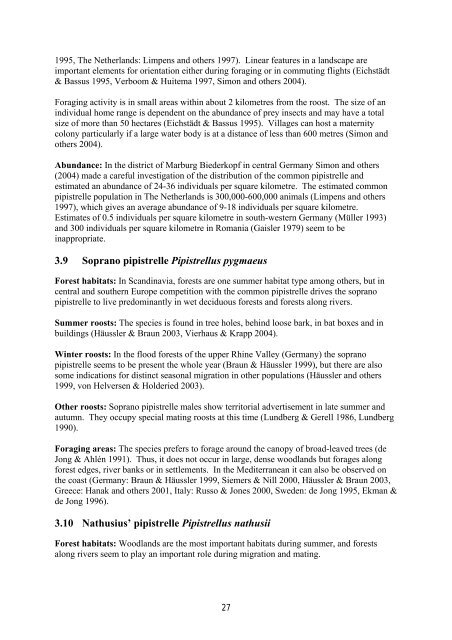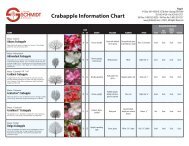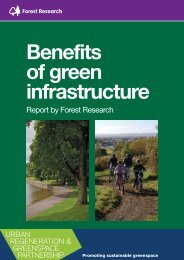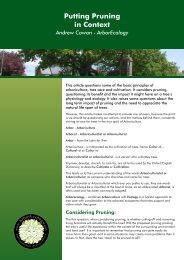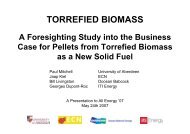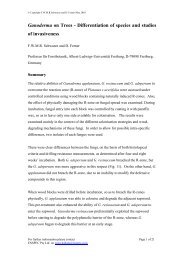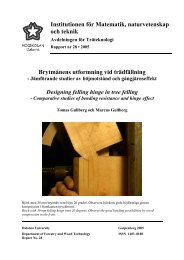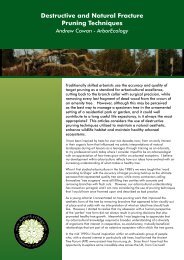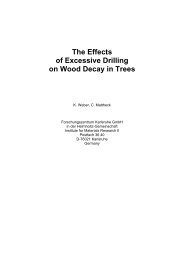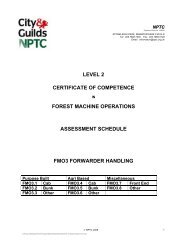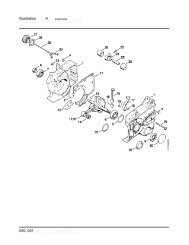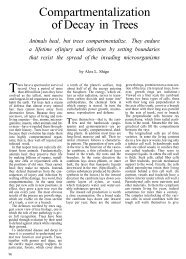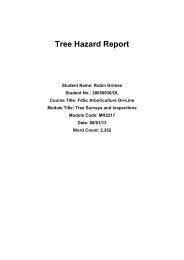continuous woodlands are smaller than those in fragmented <strong>for</strong>ests (Kerth and others 2002,Lüttmann and others 2003).3.8 Common pipistrelle Pipistrellus pipistrellusForest habitats: Although most maternity colonies are in buildings, <strong>for</strong>ests of any type areused as roosting and <strong>for</strong>aging areas, particularly if open water is in the vicinity.Summer roosts: The species mainly occurs in settlements and is even present in city centres.In summer the roost sites are predominantly in crevices in buildings (Dietz & Weber 2000),especially between tiles and the underlying roofing or behind boards on the gable (e.g.Rackow 1994). Furthermore, individuals and maternity colonies use tree holes, woodcrevices, and bird or bat boxes as roosts (Eichstädt & Bassus 1995). Summer roosts arechanged frequently, on the average every 11-12 days, so that colonies develop a roost sitenetwork with subgroups that change their composition each day (Feyerabend & Simon 2000).The common pipistrelle can be associated with all other bat species that roost in buildings(Meinig & Boye 2004, Taake & Vierhaus 2004). Ohlendorf (1998) observed the speciestogether with Nathusius’ pipistrelle and Brandt’s bat in bat boxes.Winter roosts: The common pipistrelle hibernates in large caves or other undergroundrooms, but also in crevices in the outside walls of buildings (Meinig & Boye 2004, Simonand others 2004). The animals are usually not visible as they hide in narrow crevices wherethey have as much body contact as possible with the surrounding (Simon & Kugelschafter1999).In many regions of Germany and elsewhere there are mass hibernacula where manythousands of the common pipistrelle stay during winter (Dobrosi n.y., Decu and others 2003,Simon and others 2004, Uhrin 1995). At one of these German sites, <strong>for</strong> example, wheremating is also recorded, genetic relatedness with the bats from the surrounding landscapewith a radius of about 100 kilometres was proved (Hüttenbügel and others 1998).Some individuals migrated across nearly 770 kilometres and successful homing was observedin specimens that were translocated more than 143 kilometres from their roost (Grimmberger& Borg 1979, Roer 1981, 1989). But usually the species is sedentary and the distancebetween summer and winter roosts is not more than 50 kilometres (Grimmberger & Bork1979, Haensel 1979, Simon 1998).Other roosts: After weaning of the young, the common pipistrelle visits temporary roostsites (Simon and others 2004). At this time the animals are swarming at hibernacula (Sendor& Simon 1998), probably to check the locality and its suitability <strong>for</strong> hibernation (Simon andothers 2004).Foraging areas: The common pipistrelle is abundant nearly everywhere in its range.Foraging areas are mainly along edge structures, e.g. <strong>for</strong>est edges, hedges, foot paths and<strong>for</strong>est roads, water banks, and at street lights (Austria: Spitzenberger 2001, Czech Republic:Vlasin & Malkova 1998, Denmark: Baagøe 2001a, Germany: Meinig & Boye 2004, Simonand others 2004, Greece: Hanak and others 2001, Hungary: Dobrosi n.y., Italy: Spagnesi andothers 2000, Luxembourg: Harbusch and others 2002, Poland: Kowalski & Ruprecht 1981,Woloszyn 2001, Spain and Portugal: Benzal and others 1991, Switzerland: Haffner & Stutz26
1995, The Netherlands: Limpens and others 1997). Linear features in a landscape areimportant elements <strong>for</strong> orientation either during <strong>for</strong>aging or in commuting flights (Eichstädt& Bassus 1995, Verboom & Huitema 1997, Simon and others 2004).Foraging activity is in small areas within about 2 kilometres from the roost. The size of anindividual home range is dependent on the abundance of prey insects and may have a totalsize of more than 50 hectares (Eichstädt & Bassus 1995). Villages can host a maternitycolony particularly if a large water body is at a distance of less than 600 metres (Simon andothers 2004).Abundance: In the district of Marburg Biederkopf in central Germany Simon and others(2004) made a careful investigation of the distribution of the common pipistrelle andestimated an abundance of 24-36 individuals per square kilometre. The estimated commonpipistrelle population in The Netherlands is 300,000-600,000 animals (Limpens and others1997), which gives an average abundance of 9-18 individuals per square kilometre.Estimates of 0.5 individuals per square kilometre in south-western Germany (Müller 1993)and 300 individuals per square kilometre in Romania (Gaisler 1979) seem to beinappropriate.3.9 Soprano pipistrelle Pipistrellus pygmaeusForest habitats: In Scandinavia, <strong>for</strong>ests are one summer habitat type among others, but incentral and southern Europe competition with the common pipistrelle drives the sopranopipistrelle to live predominantly in wet deciduous <strong>for</strong>ests and <strong>for</strong>ests along rivers.Summer roosts: The species is found in tree holes, behind loose bark, in bat boxes and inbuildings (Häussler & Braun 2003, Vierhaus & Krapp 2004).Winter roosts: In the flood <strong>for</strong>ests of the upper Rhine Valley (Germany) the sopranopipistrelle seems to be present the whole year (Braun & Häussler 1999), but there are alsosome indications <strong>for</strong> distinct seasonal migration in other populations (Häussler and others1999, von Helversen & Holderied 2003).Other roosts: Soprano pipistrelle males show territorial advertisement in late summer andautumn. They occupy special mating roosts at this time (Lundberg & Gerell 1986, Lundberg1990).Foraging areas: The species prefers to <strong>for</strong>age around the canopy of broad-leaved trees (deJong & Ahlén 1991). Thus, it does not occur in large, dense woodlands but <strong>for</strong>ages along<strong>for</strong>est edges, river banks or in settlements. In the Mediterranean it can also be observed onthe coast (Germany: Braun & Häussler 1999, Siemers & Nill 2000, Häussler & Braun 2003,Greece: Hanak and others 2001, Italy: Russo & Jones 2000, Sweden: de Jong 1995, Ekman &de Jong 1996).3.10 Nathusius’ pipistrelle Pipistrellus nathusiiForest habitats: Woodlands are the most important habitats during summer, and <strong>for</strong>estsalong rivers seem to play an important role during migration and mating.27
- Page 3: English Nature Research ReportsNumb
- Page 7 and 8: ContentsPreamble1. Legal aspects...
- Page 9 and 10: 1. Legal aspectsThere are three int
- Page 11 and 12: to the Agreement decided that the c
- Page 13 and 14: Country European Community EUROBATS
- Page 15 and 16: types in Europe where many of the e
- Page 17 and 18: • the European Commission initiat
- Page 19 and 20: Foraging areas: Central European sp
- Page 21 and 22: Other roosts: In foraging areas and
- Page 23 and 24: Brandt’s bat travels up to 250 ki
- Page 25: others 2004). Maternity colonies al
- Page 29 and 30: from a maternity colony covered a t
- Page 31 and 32: hibernaculum is the Levensau Bridge
- Page 33 and 34: female (Fuhrmann and others 2002).
- Page 35 and 36: Foraging areas: In Central Europe f
- Page 37 and 38: Table 2 Importance of tree holes fo
- Page 39 and 40: sites it was found that the possibi
- Page 41 and 42: advancing age of a tree its potenti
- Page 43 and 44: floor up to the canopy and beyond c
- Page 45 and 46: Table 6 Overview of the most freque
- Page 47 and 48: 6.2 2nd step: Active search for roo
- Page 49 and 50: This first approach to a woodland b
- Page 51 and 52: number of tree-dwelling birds in pr
- Page 53 and 54: Types of boxes used by batsThere ar
- Page 55 and 56: oxes exposed to the sun. As an exam
- Page 57 and 58: Con: Bats use bat boxes selectively
- Page 59 and 60: 9. ReferencesABULADZE, A., BUXNIKAS
- Page 61 and 62: BEKKER, J.P. 1990. Ervaringen met v
- Page 63 and 64: BRAUN, M., & HÄUSSLER, U. 2003c. K
- Page 65 and 66: Ökologie und Verbreitung von Arten
- Page 67 and 68: (Germany). In: PRIEDE, I. G. & SWIF
- Page 69 and 70: (Nyctalus leisleri) sowie zur Besie
- Page 71 and 72: HEISE, G. 1985. Zu Vorkommen, Phän
- Page 73 and 74: JONES, G. 1990. Prey selection by t
- Page 75 and 76: (Chiroptera: Vespertilionidae). - P
- Page 77 and 78:
Ökologie und Verbreitung von Arten
- Page 79 and 80:
PÉREZ, J. L. & IBÁÑEZ, C. 1991.
- Page 81 and 82:
ROTTMANN, R., BOYE, P. & MEINIG, H.
- Page 83 and 84:
SCHORCHT, W., and others. 2002. Zur
- Page 85 and 86:
STUTZ, H.-P. B. & HAFFNER, M. 1989.
- Page 87 and 88:
WAGNER, M., KERTH, G. & KÖNIG, B.
- Page 89:
10. AuthorsDr. Peter Boye became fa


